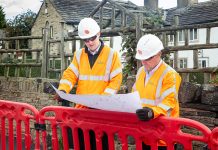Those alarming aerial images of towns and villages across the UK being engulfed by murky water might be fading from our memories, but we are heading into another winter beset by frequent storms, according to many forecasters.
These long-term forecasts are likely to make many of us who live in coastal or riverside locations nervous, since for some UK towns and villages rebuilding operations are still ongoing after Storms Eva, Frank and Desmond took their toll.
And since our flood defences and town planning have been caught out over the past 6 or 7 years by unprecedented weather events, utility firms are putting their minds to finding more robust solutions and prevention strategies in the face of increasingly unpredictable weather patterns.
Utility companies bear the brunt of flooding when water comes up through over-burdened sewer systems, and recent floods have affected wastewater treatment plants and pumping stations, cutting water services across the UK, including in Cumbria and Lancashire during Christmas 2015 and New Year 2016.
The impact of Storms Eva, Frank and Desmond, which hit the UK in quick succession, saw utility companies gather together for resilience meetings, putting non-urgent work on hold to respond to urgent issues in sewers, and sharing manpower and equipment once floods hit.
And with winter upon us minds are focussed ever more sharply on prevention.
Sue Paton, Sales and Commercial Director at Morgan Marine, a leading specialist in GRP and steel housing solutions, says all utility firms should think carefully about girding infrastructure now, in preparation for further severe weather events.
“We have been approached by Natural Resources Wales and by a number of the water companies we supply, about protecting their own critical equipment in the event of flood disaster.
“All of the utility companies across the UK house some of their critical infrastructure in kiosks and housings, which are typically fabricated from GRP, brick or steel. We have developed systems of raising the housings above the flood risk zone effectively mounting the housing on load bearing steel legs, we also provide the access stairways and landings to gain access to the raised housing.
“We have also just added the new Trojan LPCB SR3 and 4 single and multi leaf access covers to our range. This product will be particularly valuable to our clients in the water sectors by helping to secure chambers. Our highly skilled engineering and manufacturing team has designed the Trojan access cover range after pressure from several clients to add this product to our already comprehensive range of LPCB products.
“Typically, and for the past 50 years, our products have been used to safeguard against criminal damage, tampering and latterly terrorist attack, but flood defence has, in recent years, become one of the most pressing issues for our clients.
“In response to this we are carrying out further testing to meet our client’s changing demands. Morgan Marine has invested heavily over the past 5 years in developing its range of LPCB security rated products and carry security level ratings of SR2, 3 and 4, they go through very vigorous attack simulations using tools from sledge hammers to angle grinders. We are now directing our focus to further flood prevention methods.
“Our housings are all designed, engineered and manufactured by us and they are bespoke according to the needs of our clients so we are able to make modifications according to shifting circumstances.”
Combating flooding is not the responsibility of any one organisation – the Highways Authority, local authorities, the police and insurance companies all play their part in a range of recovery activities.
The Environment Agency is responsible for managing flooding from rivers in England and for most flood defences in the UK. But if floods overwhelm sewers, causing back up or overflow, then wastewater companies have to put it right.
Water and sewerage companies must clear up any spills from public sewers, and pumping stations and they are responsible for getting drinking water back on line.
And, of course, they also have a duty to protect critical assets, such as pumping stations, from floods.





